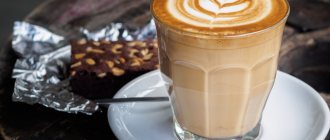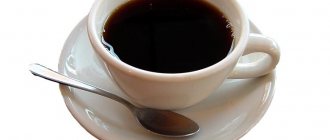Most people drink their coffee sweet. A pure black drink can taste sour (Arabica) or bitter (Robusta), or it can combine both of these shades. Sweeteners are especially often added to instant drinks in order to somehow dampen the chemical taste and make it at least a little tasty. And if coffee itself contains almost no calories, then even a spoonful of granulated sugar significantly increases the calorie content of the drink. But many of us drink not from a small cup, but from a large mug, and put two spoons, and even heaped ones. So how to calculate the calorie content of coffee with sugar, depending on various parameters?
How many calories are in a cup of coffee with sugar?
The fruits of the coffee tree themselves are quite high in calories. Roasted coffee beans have a calorie content of 223 kcal per 100 grams. But not all of these calories end up in the finished drink, since water-soluble substances in it make up only 20-29%. Therefore, the nutritional value of black coffee in its ready-to-drink form is 2 Kcal per 100g.
Few people drink coffee in its pure form without any additional ingredients. To improve and soften its taste, sugar, milk, cream, various liqueurs, all kinds of syrups, honey, ice cream, chocolate and much more are added. It is these components and the chosen method of preparation that determine the calorie content of this ancient drink.
The average calorie content of coffee without sugar is 2 Kcal per 100 ml volume. Americano contains 1 kcal, espresso 4 kcal of energy. The calorie content of instant coffee “without impurities” is 7 Kcal.
To calculate how many calories are in a cup of coffee, take an average 250 ml cup. It turns out that a cup of natural coffee without various additives contains only 5 Kcal, while instant coffee contains 17.5 Kcal. When you add other ingredients, the number of calories will immediately increase.
On average, one teaspoon of sugar has an energy value of 24 kcal. Dairy cream (35%) contains 340 Kcal (per 100 ml), vegetable cream – 30 Kcal. Milk with a fat content of 3.5% has an energy value of 60-65 kcal.
Knowing how many calories are in coffee without sugar, you can easily calculate the energy content of coffee in combination with these components. First, let's find out how many calories are in coffee with sugar.
Popular articles for weight loss and health
Chia pudding: recipe with coconut milk
Diet 5 spoons: menu for the week real reviews
Homemade granola diet recipe
One Glass Diet
Let's imagine that three teaspoons of sugar are placed in a cup with a capacity of 250 ml. It turns out that a cup of freshly brewed coffee with sugar will have a caloric content of 77 calories.
In a similar way, you can calculate how many calories are in coffee with milk. If we imagine that 50 ml of milk is added to a standard cup, then through simple calculations we find that the calorie content of coffee with milk without sugar will be approximately 34 Kcal (in a 250 ml cup).
A cup of coffee with heavy cream without added sugar contains about 174 kcal. The calorie content of coffee with milk and sugar will be equal to 106 Kcal of energy.
Alcoholic and non-alcoholic liqueurs, syrups, chocolate, cinnamon, ice cream, condensed milk, honey, lemon, and egg yolk are often added to this Arabic drink. With these additions, coffee will significantly change its energy value.
Energy value
In its pure form, without any additives, it does not have many calories. Considering not only its pleasant taste and invigorating properties, but also its ability to accelerate metabolic processes, nutritionists recommend consuming it even during diets. Coffee, the calorie content of which often does not raise any questions, even with the addition of sugar becomes completely unsuitable for those who want to lose weight.
A coffee drink with milk and sugar can be safely drunk by those who expend a lot of energy during the day. Without compromising their figure, only people engaged in physical labor or athletes can afford to drink glasse, moccacino, and cappuccino. Of course, sometimes everyone can indulge in such a tasty treat once every few days, not forgetting the high calorie content of the drink.
The amount of calories consumed depends on several factors:
- method of preparation (types of additives and their quantity);
- number of cups drunk per day;
- the size of a regular cup of coffee.
Of course, only those who are on a strict diet conduct scrupulous calorie counting. The rest just need to take note of its calorie content and not abuse it.
What are the caloric content of coffee additives?
Often, when we make coffee at home, we add various additives to the drink to give it a more interesting taste. Each of these additives can significantly increase the calorie content of a cup of coffee with milk. All people who monitor their health and excess weight need to know the calorie content of each such supplement.
Sugar is the most popular additive, which softens the bitter taste of coffee and instantly turns the invigorating drink into a kind of dessert. Even children sometimes drink coffee if you add sugar or powdered sugar to it. However, you need to be careful with this supplement: 100 grams of sugar contains 387 kcal, and one teaspoon contains 8 grams of sugar. This means that with one teaspoon you immediately add 31 kcal to your coffee. Sweeter coffee lovers, adding 2 teaspoons, get 62 kcal instead of the harmless 4 kcal. You can slightly reduce the calorie content of the drink if you add honey instead of sugar: 1 teaspoon of honey contains 26 kcal, and 2 teaspoons - 52 kcal.
Cream is an excellent alternative to milk because it has a more pronounced creamy taste. The calorie content of cream depends on its fat content. So, cream with a fat content of 10% contains 119 kcal, 20% - 207 kcal, 35% - 335 kcal. One teaspoon contains 5 grams of cream. By simple calculations you can calculate: 1 teaspoon of cream 10% fat contains 6 kcal, 20% - 10 kcal, 35% - 17 kcal.
Chocolate is added to coffee to give it a sweet taste. Chocolate is also used in the preparation of various variations of mochaccino. Using real chocolate is not very convenient, so chocolate syrup, which contains about 149 kcal, is popular. 1 teaspoon contains 25 grams of chocolate syrup. This means that one teaspoon of syrup adds 35 kcal to the coffee drink.
Condensed milk combines the properties of sugar and milk. This additive perfectly sweetens the drink, gives it a beautiful color, and adds milky notes. However, condensed milk itself is very high in calories. Its calorie content is 321 kcal. One teaspoon contains approximately 11 grams of condensed milk. By adding 1 spoon of condensed milk to coffee, you immediately increase its calorie content by 35 kcal.
Calorie content of tea with honey
Honey is not only a beloved sweet by many, but also a healthy product that many people use to replace sugar. Even though the calorie content of honey is not much lower than that of sugar, you will get more benefits from a spoon of honey. The carbohydrates it contains are more easily absorbed by the body and are not stored as fat reserves, and the amount of essential elements in it is simply off the charts! These are B vitamins, vitamin C, enzymes, amino acids, iodine, potassium, iron and other essential microelements.
The calorie content of honey depends on its variety: the most “dietary” is buckwheat honey - 100 g of the product contains 300 kcal. Dark varieties of honey can reach a calorie content of 400 kcal per 100 g. On average, a teaspoon of honey contains about 26 calories. By adding a couple of spoons to tea, you will get about 60 kcal per serving.
Tea with honey is an excellent remedy for treating cold symptoms. The main thing is not to add honey to boiling water - this can “kill” the beneficial substances and the drink will lose its healing properties. The temperature of the drink should not be higher than 40 degrees. Honey contains antioxidants, as well as immune-stimulating and antimicrobial substances. When combined with black or green tea, you get a real medicine for all diseases. However, if you are watching your caloric intake and are concerned about extra pounds, your consumption of this drink should be limited to one cup per day.
ul
When and who can drink coffee?
You love coffee and cannot imagine a single morning without this invigorating drink. At the same time, you drink several cups a day, not paying attention to your well-being and the time of day.
Is it worth giving up this habit, for example, during pregnancy?
Pregnancy is a period when a woman is forced to limit herself in many ways so as not to harm the health of the unborn child. But should coffee be included in the list of restrictions?
There are different opinions on this matter, but it makes sense to turn to authoritative sources. One of them is the World Health Organization (WHO).
WHO recommendation
If your pregnancy is progressing normally, there is no need to stop drinking coffee during pregnancy. However, it makes sense to limit its amount - no more than 300 milligrams of caffeine per day.
As you know, one hundred grams of coffee contains 40 milligrams of caffeine. It turns out that 300 milligrams of caffeine is 750 grams of coffee drink. This is approximately the amount of caffeine found in large coffee from the American coffee chain Starbucks.
According to research, 300 milligrams of caffeine per day is exactly the minimum dose after which caffeine addiction can begin to form. Experts from the Russian Federal Research Center (FRC) of Nutrition, Biotechnology and Food Safety do not agree with WHO recommendations.
Harm of instant coffee
Despite a number of beneficial properties of instant coffee, doctors and nutritionists recommend avoiding such drinks. The dangers of instant coffee are as follows:
- it is saturated with flavor enhancers and dyes that disrupt the gastrointestinal tract;
- coffee leads to dehydration of the body, as a result of which immunity decreases and the condition of nails and hair worsens;
- with high blood pressure, excessive coffee consumption can cause serious problems with the heart and blood vessels;
- instant coffee is full of caffeine, which should be avoided if you have sleep disorders;
- When taking sedatives, instant coffee is also contraindicated, since the drink promotes stimulation of the nervous system.
SUBSCRIBE TO SITE UPDATES
Many of us enjoy the aroma of morning coffee. True connoisseurs of this tasty and invigorating drink love to indulge in it throughout the day. Well, what's a work break, business or friendly meeting without coffee? The general coffee mania has embraced everyone: computer lovers, housewives, fans at stadiums, office workaholics, and people on vacation prefer to cheer them up. Paying tribute to the exquisite taste and tonic properties, few people think about the energy value of this drink. Meanwhile, all kinds of additives make it very high in calories, which may not have the best effect on your figure.
Is it possible to have coffee with high blood pressure?
There is always a lot of controversy surrounding coffee. One of the most common is related to whether drinking coffee affects blood pressure, and if it does, how exactly? In fact, hundreds of studies have been conducted to identify the relationship between blood pressure and coffee consumption.
But none of the studies have found a direct link between coffee consumption and an increased risk of a significant increase in blood pressure. In this case, we were talking about an amount not exceeding 400 milligrams of caffeine per day. Moreover, no relationship was found with an increase in cardiovascular diseases.
Calorie content of gourmet drinks
https://youtube.com/watch?v=wdtobFE0-L8
If everything is more or less clear with black coffee, then its various types with tempting names, which are often replete with the menu of any cafe and restaurant, can be fraught with a lot of pitfalls in the form of extra calories. The most harmless in this sense is classic espresso - fairly strong coffee to which nothing is added. A small invigorating cup will add only 2-3 kcal. It's more difficult with varieties of espresso. For example, a serving of espresso macchiato, which is usually 250 milliliters in volume, contains 55 kcal. Calorie content is increased by adding milk foam. But espresso con panna will have twice the calorie content due to the white foam with the addition of ground cinnamon.
A serving of Americano will not harm those losing weight. A large cup with a volume of 400-450 milliliters contains only about 15 kcal. The same, unfortunately, cannot be said about the very tasty mocaccino, brewed on the basis of espresso with the addition of chocolate and milk, which will add up to 290 kcal. And this is only for 100 milliliters! A beautiful latte is traditionally served in special oblong glass cups so that the layers of coffee, milk and thick foam are clearly visible. A serving of this drink, which is usually 300–350 milliliters, contains 230–250 kcal. And this is without adding sugar to it. Spicy Irish coffee, which contains espresso, cream, whiskey and sugar in varying proportions, has a slightly lower energy value. There are 170 calories per 150 milliliters.
A standard 150-milliliter serving of cappuccino contains at least 200 kcal. The fact is that it is prepared in such a way that sugar is added to the initially harmless espresso in terms of calorie content, as well as thick milk foam, whipped from high-fat milk and cream. You don’t have to add sugar, but this won’t help the situation much, reducing calorie content by 24–48 kcal.
Does this mean that coffee does not affect blood pressure?
Specialists from the Federal Research Center for Nutrition, Biotechnology and Food Safety cite the results of international studies, according to which consuming caffeine in amounts of 100 to 1000 milligrams per day can indeed cause a slight and short-term increase in blood pressure, which has not been recognized as dangerous.
Popular articles for weight loss and health
How many calories: turkey drumstick
How many calories are in sea buckthorn
How many calories are in quince?
How many calories are in pea soup
Oysters in cooking
In France and Belgium, oysters are a delicacy and must be eaten alive. If the oyster is dead, it means it is spoiled and should not be eaten. The most important criterion for freshness is a tightly closed sink.
But if there is even a small gap in the shell, it means that the oyster is no longer fresh and cannot be eaten. Open the oyster with a special oyster knife or medical scalpel. It is inserted into the place where the valves are connected by a lock, and carried out along the center of the oyster and from the flat side of the shell, to the muscle that locks the valves.
When the shell opens, you need to touch the edge, where you can discern a darkish line of cilia. If the oyster is alive, it will shudder, but if it remains motionless, it means that it is dead and not suitable for food.
Eating oysters is very simple - lightly sprinkle with lemon juice and simply “drink” from the recessed, curved side of the shell. They eat an oyster, as a rule, with black bread (it is imported into France exclusively for the sake of oysters), and wash it down with either light beer or dry white wine.
In a number of countries, they produce canned oysters, which are already fried or boiled semi-finished products, which, like mussels and crabs, are used in salads and soups in finely chopped form. They do not have the beneficial properties of fresh oysters, and their taste is completely different.
The benefits of counting calories
Many modern nutritionists are of the opinion that the theory of calorie counting is somewhat outdated. It was created in the 19th century, when scientists were convinced that the human stomach works on the principle of a conventional oven in which food is burned.
In fact, the chemical reactions that occur during the digestion of food are much more complex than combustion. In order not to gain weight, you really shouldn’t abuse fatty and sweet foods, but not only because of their calorie content, but because they contain few vitamins.
Coffee and milk drinks with sugar, chocolate and other additives should be considered dessert. Those who are watching their figure should not drink these cocktails more than 2-3 times a week. It is advisable not to snack on them with pastries or sweets, and after particularly rich desserts, such as affogato or iced coffee, it is better to refuse dinner.
Benefits, harms, calorie content of cappuccino per 100 grams
The calorie content of cappuccino coffee without sugar with milk per 100 grams is 45 kcal. 100 g of drink contains:
- 1.9 g protein;
- 2.5 g fat;
- 4 g carbohydrates.
To prepare cappuccino with milk without sugar you need:
- heat 100 ml of milk to a boil;
- hot milk is poured into a blender and whipped until thick foam;
- 100 ml of black coffee without sugar is brewed;
- the resulting foam is spooned into the finished coffee;
- For taste, grate 5 g of chocolate into cappuccino.
Calorie content of cappuccino from McDonald's without sugar per 100 grams
Calorie content of McDonald's cappuccino without sugar per 100 grams is 42 kcal. 100 g of drink contains:
- 2 g protein;
- 2.3 g fat;
- 3 g carbohydrates.
Read: Calorie content of fresh Chinese cabbage
The main components of a McDonald's cappuccino are ground roasted coffee beans, milk with 3.5 percent fat, and purified and prepared drinking water. Initially, the drink is prepared without sugar. If you decide to sweeten it, keep in mind that 1 teaspoon of sugar will increase the calorie content of your cappuccino by about 25 kcal.
Calorie content of cappuccino with soy milk per 100 grams
Calorie content of cappuccino with soy milk per 100 grams is 21 kcal. A 100 gram serving contains:
- 1 g protein;
- 1 g fat;
- 3 g carbohydrates.
Cappuccino recipe with soy milk:
- 1.5 teaspoons of ground coffee are poured into 100 ml of water and brought to a boil in a Turk;
- 60 ml of soy milk is heated to a boil and whipped until thick foam;
- the coffee is filtered into a cup, the foam of soy milk is spooned into it;
- sugar is added to taste.
Calorie content of cappuccino from a 100 gram machine
The calorie content of a 100 gram cappuccino from a machine is 105 kcal. In 100 g of drink:
- 5 g protein;
- 4.9 g fat;
- 7.1 g carbohydrates.
Read: Calorie content of bran bread
Calorie content of cappuccino with sugar per 100 grams
When calculating the calorie content of cappuccino with sugar per 100 grams, the type of product is taken into account. So, 100 g of cappuccino from McDonald's will contain 67 kcal, a drink from a machine will contain 130 kcal, and a cappuccino with soy milk will contain 46 kcal. The indicated number of calories is relevant when adding 1 teaspoon of sugar to coffee.
Calorie content of vanilla cappuccino per 100 grams
The calorie content of vanilla cappuccino per 100 grams is 188 kcal. In 100 g of drink:
- 4.6 g protein;
- 7.5 g fat;
- 26.3 g carbohydrates.
The high calorie content of such coffee makes it contraindicated for diabetes, overweight, during weight loss and dieting. In addition, this cappuccino from a machine contains a lot of preservatives, dyes, and artificial sugar substitutes that are harmful to health.
Calorie content of cappuccino in 1 cup
The calorie content of cappuccino in 1 cup depends on the type of drink. So, one 200 gram cup of coffee will contain:
- cappuccino from McDonald's without sugar - 84 kcal, 4 g protein, 4.6 g fat, 6 g carbohydrates;
- cappuccino with soy milk – 42 kcal, 2 g protein, 2 g fat, 6 g carbohydrates;
- cappuccino from a machine – 210 kcal, 10 g protein, 9.8 g fat, 14.2 g carbohydrates;
- vanilla cappuccino – 376 kcal, 9.2 g protein, 15 g fat, 52.6 g carbohydrates.
Read: Calorie content of boiled rice in water
Calorie content of cappuccino with syrup per 100 grams
Calorie content of cappuccino with syrup per 100 grams is 85 kcal. In 100 g of drink:
- 0.7 g protein;
- 1 g fat;
- 11.2 g carbohydrates.
The benefits of cappuccino
The following benefits of cappuccino have been proven:
- this coffee is rich in vitamin PP, calcium, iron, magnesium;
- caffeine in cappuccino stimulates the functioning of the brain and nervous system;
- coffee is recommended for low blood pressure;
- the drink speeds up metabolism and activates the stomach;
- Thanks to the vasodilating effect of cappuccino, it is useful for removing excess fluid from the body.
Harm of cappuccino
Having considered the benefits of coffee, let’s say a few words about the dangers of cappuccino:
- the drink is contraindicated for high blood pressure;
- You should avoid drinking cappuccino if you have overexcitability of the nervous system, migraines, or arrhythmia;
Read: Calorie content of vodka in 100 grams
- drinking cappuccino on an empty stomach contributes to the exacerbation of gastritis and many other gastrointestinal diseases;
- cappuccino with sugar is prohibited if you have diabetes;
- The caffeine in the drink flushes sodium, calcium and iron from the body.
SUBSCRIBE TO SITE UPDATES
By clicking the button, I agree to the newsletter, the processing of personal data and accept the privacy policy.
ul











